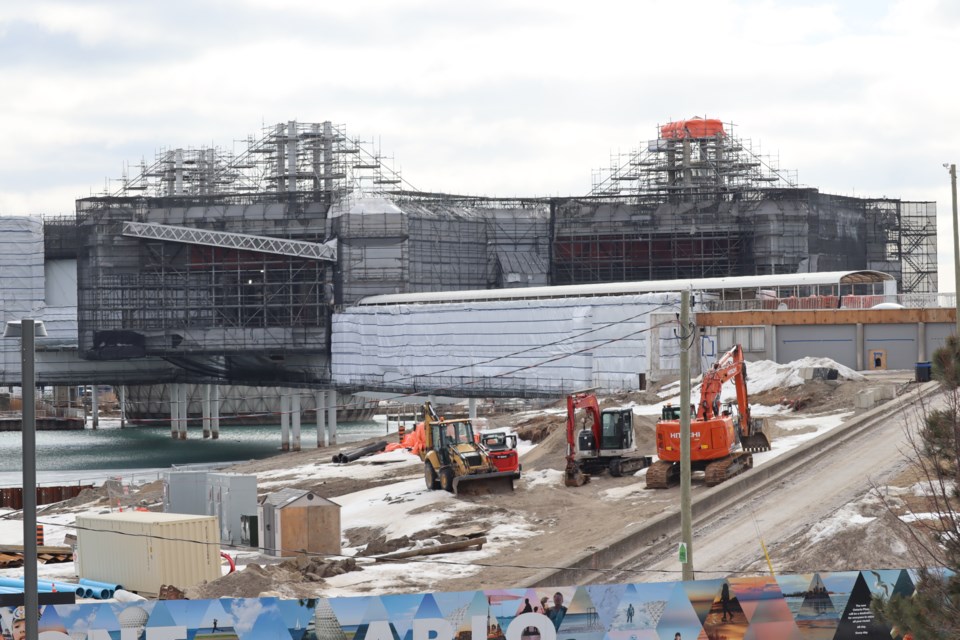A bill introduced at Queen's Park in April would exempt all Ontario Place-related infrastructure work from public consultation requirements under the province's Environmental Bill of Rights.
This comes months after the province withdrew plans for a controversial sewage pipe that aimed to pump water waste into Ontario’s Place’s West Channel — a proposal that garnered public opposition after it was posted on the Environmental Registry of Ontario.
The new legislation would allow that step to be skipped for future projects on the waterfront lands.
The measure is just one piece of Bill 5, the Protect Ontario by Unleashing our Economy Act, which Premier Doug Ford’s government has pitched as an economic response to U.S. President Donald Trump's tariffs.
The Ontario Place site has been levelled in recent months, hundreds of trees replaced by construction equipment as the province moves to prepare the site for a spa run by Therme, a Vienna-based company.
The province’s demolition deadline is April 30, 2026, according to the lease signed with Therme.
Ann-Elisabeth Samson, co-chair of Ontario Place for All, a group opposed to the redevelopment, thinks Bill 5 is intended to get the project moving faster. Removing a legally required public notice period is one way to achieve speed.
"They are really trying to rush things,” she said. “I think that the longer it takes before they hand things over (to Therme), the more chance there is of the deal getting kind of scuttled."
Infrastructure Minister Kinga Surma's office said plenty of consultation and assessment of Ontario Place has already been completed, and the legislation is necessary to avoid “cost overruns due to duplicative delays.”
"Two publicly available environmental assessments and more than 40 different studies and reports have informed the project, as well as consultations with Indigenous communities, the City of Toronto and more than 9,300 members of the public," Ash Milton, a spokesperson for Surma, told TorontoToday this week.
"Our legislation ensures that approvals and compliance are streamlined so the rebuilding of Ontario Place happens on time," Milton added.
Samson also interprets the move as a simple display of power.
"Sometimes I think it's spite. It's like, we're going to completely crush you because we can," she said of the Ford government.
Advocates raised concerns about sewer plan this winter; similar work may remain secret in the future
In February, the province withdrew a controversial plan to locate a sewer outflow in the West Channel, on the western side of Ontario Place.
Advocates warned that the proposed sewage pipe, which came to light due to the environmental notification process, would pollute the channel as well as public swimming and rowing areas further west at Sunnyside Beach.
The notice on the Environmental Registry received thousands of public comments. Most respondents said they opposed the sewage pipe because of its potential impact on water quality.
“The West Channel is used by swimmers, rowers and kayakers,” states one submission. “Emptying the combined sewer outlet into the West Channel of Lake Ontario will pollute the channel with bacteria and sewage. This approach is not environmentally responsible … When planning for construction of the Therme Spa, this issue should have been identified and dealt with in an environmentally responsible manner.”
The government denied the sewage outflow would impact water quality but later withdrew the proposal.
A ministry spokesperson told TorontoToday last month that measure was taken “to ensure compliance with federal regulations surrounding the spring fish breeding season.”
Asked for further information, spokesperson Sofia Sousa-Dias said “We’re revisiting our plans to determine when we can continue this work.”
Two days later, Bill 5 was tabled at Queen’s Park.
What else is in Bill 5?
Bill 5 would also give the province the power to designate “special economic zones” that fit criteria to be developed by cabinet.
Cabinet would then be empowered to exempt selected proponents and projects from requirements under any provincial law or regulation, including bylaws of municipalities and local boards, that would otherwise apply in that zone.
Ford's government has said it would use these powers to enable companies to more quickly access minerals from the resource-rich Ring of Fire in northern Ontario.
The bill also repeals the Endangered Species Act and replaces it with legislation that environmental groups argue offers far weaker protection; empowers cabinet to exempt projects from archeological assessment requirements; proposes to streamline mining approvals; and allows the government to limit foreign actors' participation in the energy sector, mining industry and critical infrastructure projects.
Indigenous leaders have called on the government to halt debate on the bill and consult on it, warning that failing to do so will spark confrontations "on the ground" and in the courts.
On Tuesday, Bill 5 passed second reading at Queen’s Park.
The Standing Committee on the Interior is scheduled to hold public hearings on the legislation in Toronto on Thursday, May 22, 2025 and Monday, May 26, 2025.
Anyone who wishes to speak to the committee on the bill is required to register by 2 p.m. on May 12.




